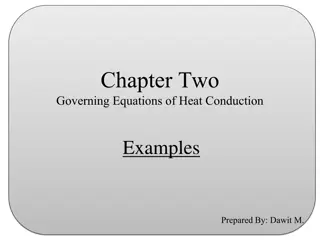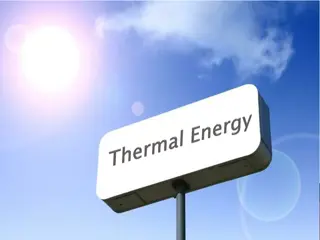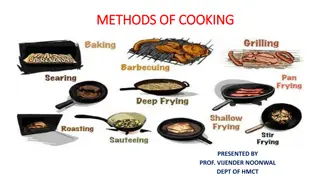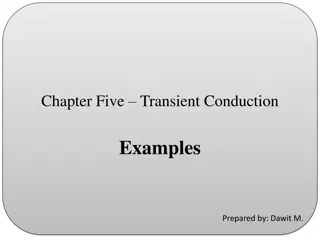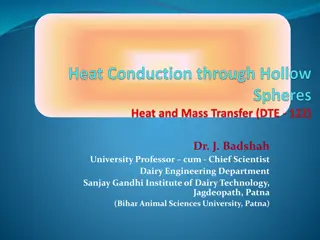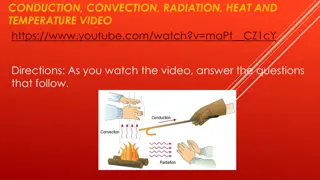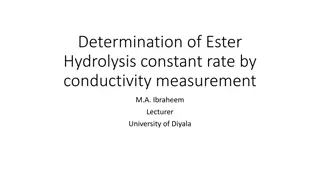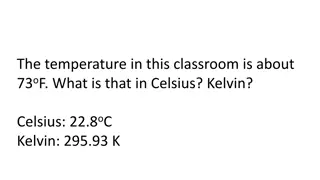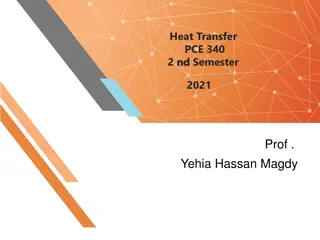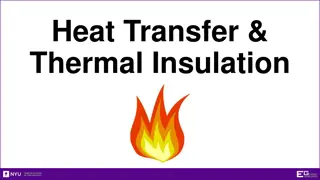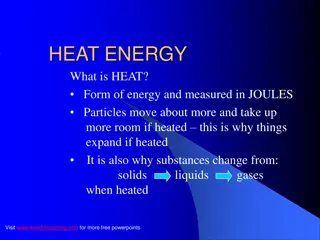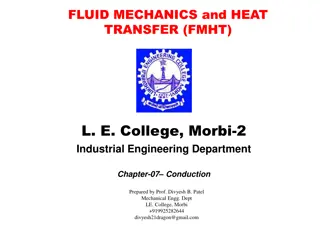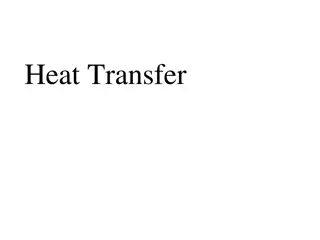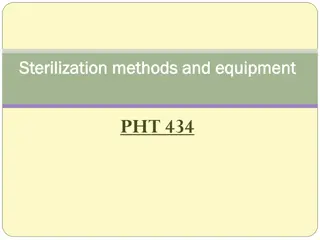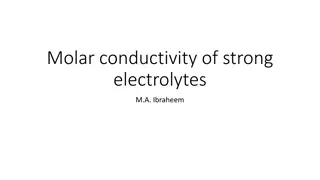Understanding Heat Transfer: Conduction, Thermal Conductivity, and More
Explore the fundamentals of heat transfer through conduction and thermal conductivity as explained by Dr. J. Badshah. Learn about the modes of heat transfer, Fourier's law, thermal resistance, and the relationship between thermal and electrical conductivity. Discover the essential features of thermal conductivity in solids, liquids, and gases, along with practical examples and analogies from electrical circuit theory.
Download Presentation

Please find below an Image/Link to download the presentation.
The content on the website is provided AS IS for your information and personal use only. It may not be sold, licensed, or shared on other websites without obtaining consent from the author. Download presentation by click this link. If you encounter any issues during the download, it is possible that the publisher has removed the file from their server.
E N D
Presentation Transcript
Modes of Heat Transfer & Analysis Dr. J. Badshah Professor and Head, Dairy Engineering SANJAY GANDHI INSTITUTE OF DAIRY TECHNOLOGY (Bihar Animal Sciences University, Patna) Email: ejazbadshah@gmail.com
Modes of Heat Transfer Conduction a. Transfer of heat without appreciable displacement of molecules forming the substance b. In solids conduction by lattice vibration or by transport of free electrons c. In gases, the kinetic energy of the molecules is a function of temperature and energy is transferred in low temperature region by collisions d. In liquid the molecules are more closely spaced than that of gases but the mechanism of heat transfer is same as that of gas e. Fourier s law of heat conduction:Q= - KA dt/dx f. The decreasing value of temperature gradient (dt/dx) will take care of ive sign in above equation. g. Area A is perpendicular to the direction of heat flow, m2, Q is in Watt if thermal conductivity K is in W/m. K and dx is the thickness in m in the direction of heat flow
Thermal Conductivity: Essential Features Definition:K = Q/A .dx/dt where Q is heat per unit time Conduction of heat proportional to K Heat conduction : In decreasing order of pure metals, alloys and non metals due to decreasing K values. K in pure metals varies from 10 to 400 W/m C, K in Alloys varies from 12 to 120W/m C K in insulating materials:0.023 to 2.9W/m. C K in liquid :0.2 to 0.7W/m. C K in gases and vapours:0.006 to 0.05W/m. C Dependence of thermal conductivity onTemperature: K = K0(1 + t), where is -1/ C for metals and liquids (Aluminium, Uranium and water being the exception)
Thermal Conductivity: Essential Features In gases the values of K increases with increase in temperature because K is proportional to mean molecular path of the molecules. But higher molecular weights gases having high density and low mean molecular path results in lower K values at the same temperature. In solids and liquids K depends weakly on pressure but in gases K is independent of pressure (near atmospheric pressures). K of damp materials of non metallic solids is considerably higher and depends on type of gas in the voids. Wiedmann and Franz Law: The ratio of the thermal (K) and electrical conductivities ( ) is the same for all metals at the same temperature.The ratio K/ is proportional to absolute temperature T Afor all metals. K/ T = C = 2.45 x 10 8 W / K2 The materials which are good conductors of electricity are also good conductors of heat.
Thermal Resistance and Electrical Analogy Electric CircuitTheory has Ohm s Law:I =V/R Fourier s Equation have Q = dt /(dx/KA) Thermal Resistance resistance R, Q is analogous to electrical current Temperature difference dt is analogous to electrical voltage difference. Therefore rules for combining electrical resistances in series and parallel will apply equally to the combination of thermal resistances. Calculate the rate of heat transfer per unit area through a copper plate 45 mm thick, whose one face at 350 C and the other face at 50 C. Take thermal conductivity of copper as 370W/m C. Q/A = -K dt/dx = -370 (50 -350)/0.045 = 2.466 x 106W/ sq. m. (dx/KA) is analogous to electrical I and
Heat Transfer by Convection Newton law of cooling:Q = h .A.(ts- tf) Factors for film heat transfer coefficient h are: Thermodynamic andTransport proprties Nature of flow Geometry of surface PrevailingThermal conditions ConvectionThermal Resistance = 1/ hA A hot plate 1 m x 1.5 m is maintained at 300 C. Air at 20 C blows over the plate. If the convective heat transfer coefficient is 20 W/m2 C. Calculate the rate of heat transfer. Solution:Q = 20 x 1.5 x (300-20) = 8400W
Heat Transfer by Radiation Laws of Radiation: Wein s Law: wavelength corresponding to the maximum energy ( m) is inversely proportional to absolute temperature of hot body Kirchhoff s Law: Emissivity of the body is numerically equal to its absorptivity for radiant energy from body at the same temperature. The Stefan- Boltzmann Law: The law states that the emissive power of a black body is directly proportional to fourth power of its absolute temperature i.e. Q T4 Q = F A ( T14- T2 Where, F = A factor depending on geometry and surface properties, Stefan- Boltzmann constant = 5.67 x 10 -8 W/m2K4 , T1 and T2 : Temperature in degrees kelvin 4)
Numericals on modes of heat transfer Solve 5 Numericals on each modes at least. A carbon steel plate (K = 45 W/m C) dimension : 600 mm x 900 mm x 25 mm is maintained at 310 C. Air at 15 C blows over the hot plate. If convection heat transfer coeficient is 22 W/m2 C and 250 W is lost from the plate surface by radiation, calculate the inside plate temperature. In this case Qcond. = Q conv. + Q radiation - K A.dt/dx = h.A ( ts tf) + F A( T14- T2 -45x0.54xx (310 ti) /0.025 = 22 x 0.54 (310-15) + 250 Therefore ti= 313.86 C 4)


